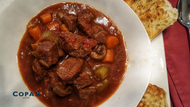Warming Lamb Stew Recipe for Crisp Autumn and Winter Days
Posted by Copas Farm Shop on 15th Sep 2025
One of the best things about the chillier months is the chance to enjoy hearty, warming stews — dishes that fill your home with the smell of slow-cooked meat and fresh herbs, and bring everyone together around the table. A lamb stew, gently simmered with vegetables and fragrant herbs, is the ultimate comfort food, especially when made with high-quality lamb. It’s simple to prepare, yet the results feel indulgent, perfect for a cosy evening.
Choosing the Right Lamb for Stew
The secret to a rich, flavoursome stew is choosing the right cut of lamb. Pieces with a little fat and connective tissue, such as neck, shoulder, or breast, are ideal. These cuts may feel tough initially, but slow cooking transforms them into tender, melt-in-the-mouth meat while enriching the sauce naturally. Free-range or pasture-reared lamb often has deeper flavour, making the slow-cooked dish even more satisfying.
Ingredients
- Stewing lamb (neck or shoulder, cut into cubes)
- Onion, carrot, celery
- Garlic, rosemary, thyme
- Stock (lamb or vegetable)
- A splash of red wine or stout (optional)
- Tomatoes (fresh or tinned)
- Root vegetables or potatoes
- Olive oil, salt & pepper
Method
- Prepare the lamb: Pat the lamb cubes dry and season generously with salt and pepper. Heat a little oil in a heavy-bottomed pot and brown the meat in small batches. Browning develops flavour and gives the stew a richer, deeper taste.
- Build the flavour base: Remove the browned lamb and gently cook the onion, carrot, and celery in the same pot until softened. Stir in garlic and herbs near the end so their aroma comes through without burning.
- Add liquids and return the lamb: Pour in the wine or stout if using, allowing it to reduce slightly. Add the stock and tomatoes, then return the lamb to the pot. Bring everything just to a gentle boil before lowering the heat to a slow, steady simmer.
- Simmer gently: Cover and cook for 90–120 minutes, or until the lamb is tender and the flavours have blended beautifully. Stir occasionally to ensure nothing sticks to the bottom.
- Incorporate vegetables: About 30 minutes before the stew is done, add root vegetables or potatoes. This ensures they cook through while still retaining their shape and texture.
- Final touches: Taste and adjust seasoning. A sprinkling of fresh parsley or a hint of lemon zest just before serving can brighten the flavours and add a fresh note.
What Goes Well With Lamb Stew?
A hearty lamb stew is lovely on its own, but pairing it with simple sides can make it even more satisfying. Crusty bread is perfect for mopping up the rich sauce. Creamy mashed potatoes, buttered dumplings, or soft polenta complement the tender lamb beautifully. For a lighter balance, lightly steamed seasonal greens like kale, spinach, or green beans add freshness, colour, and texture.
Frequently Asked Questions
Which lamb cuts are best for stew?
Neck, shoulder, and breast are ideal. Though they might seem tough at first, slow cooking transforms them into tender, flavourful pieces that give your stew body and richness.
How can I avoid a watery stew?
Browning the meat before adding liquid helps build flavour. Cook the stew slowly on low heat to allow the sauce to thicken naturally. Add root vegetables towards the end so they keep their shape and contribute texture without watering down the dish.
Why Taking Your Time Matters
Making a stew isn’t complicated, but it rewards patience. Slow cooking allows the lamb to become succulent, the sauce to deepen, and all the flavours to blend beautifully. Served with mash, dumplings, or fresh bread — plus a few steamed greens — it becomes a comforting, nourishing meal that feels like a warm hug on a chilly day.

